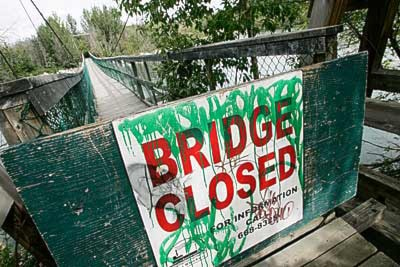There was a time, not long ago, when the trails of Kishwoot Island were well-known to Whitehorse citizens.
Well-kept trails crisscrossed the humble island, leading visitors through forest, over plains and along the riverbank.
Raspberries grew along the trailside, tantalizing island hikers.
Entrance to the island is now blocked — by a small barrier marked “bridge closed,” and covered with graffiti.
The trails now lie abandoned and overgrown, littered with the occasional broken beer bottle or rusting shopping cart.
Small wooden bridges that once led over creeks are now collapsed and rotting.
Yet, the days of an open Kishwoot may once again return — pending a go-ahead from the Ta’an Kwach’an.
The island has long existed as a city park until it was transferred to the Ta’an Kwach’an in their signing of the January, 2002 Final Agreement.
As they had done since the mid-80s, park maintenance at Kishwoot was performed by volunteers with the Yukon Outdoors Club.
“We went in twice a year, spring and fall, and did major trail clearing and cleaning up,” said Ione Christiansen, the club’s past president.
The island quickly fell into near-complete neglect following the city’s official closure of the suspension bridge due to safety concerns.
“Probably about two and a half years ago, maybe even three years ago, we identified that there was some structural deficiencies in the bridge,” said Doug Hnatiuk at Whitehorse city planning.
At around the same time, a bridge support gave way, prompting the city to install the sign that now warns of the crumbling bridge.
“We’ve done our due diligence in terms of putting a sign up to warn people not to use the bridge,” said Hnatiuk.
“Now it’s up to the Ta’an Kwach’an to deal with the bridge,” he added.
As a mysterious and isolated locale, Kishwoot lends itself easily to suspicions of underworld activities.
Only a year ago, Robbie King, 52, disappeared after going to take his dog for a walk. His dog and minivan were found abandoned near Kishwoot.
Yet the island is not traditionally a haven of lawlessness.
“Years ago we would have the odd call onto the island, but I haven’t heard recently … it was never a problem, it was just an area where people congregated,” said Sgt. Roger Lockwood, media relations for the Whitehorse RCMP.
Currently, Kishwoot does support a small population — as a place of refuge for many of Whitehorse’s homeless.
A handful of well-kept tent encampments dot the island, equipped with clotheslines, cooking areas and overhanging tarps.
Beer bottles are in frequent evidence along trails and at the bridgehead, but not at the campsites. Hypodermic needles and other evidence of hard drugs are nowhere to be found anywhere around Kishwoot.
Under comprehensive waterfront development plans, money is available to restore Kishwoot Island to its pre-bridge-failure status — all that is needed is the go-ahead from the Ta’an Kwach’an.
Twenty-two million dollars have been set aside from the federally supported Canadian Strategic Infrastructure Fund to revitalize the Whitehorse riverfront.
Buildings in Shipyards Park and ample development on First Avenue have already been the result of CSIF funding.
“There is funding available under the CSIF program to restore the bridge and work on the trails on the island, but the Ta’an has to agree to this, and they’re part of the working group — but to date they haven’t done that,” said Pat Molloy, assistant deputy minister to the Yukon government’s community development division.
Roughly $275,000 would be needed to repair the bridge, and $110,000 would be needed to repair the island’s trails, said Molloy.
If not used by March 2010, the funding will expire.
“As to whether the bridge is going to get fixed or not, I’m not sure what the (Ta’an Kwach’an) council’s position is on that,” said Simon Lapointe, lands manager of the Ta’an Kwach’an.
“We’re not sure if we want to fix it, or simply demolish it,” he said.
